Marketing Strategies During Different Stages of the Product Life Cycle
VerifiedAdded on 2023/06/12
|15
|2521
|211
AI Summary
This report highlights upon the marketing strategies adopted by businesses during the introductory stage as well as maturity stage of the product. Relevant examples have also been provided wherever required.
Contribute Materials
Your contribution can guide someone’s learning journey. Share your
documents today.

Marketing management
Marketing strategies during different stages of the product life
cycle
Marketing strategies during different stages of the product life
cycle
Secure Best Marks with AI Grader
Need help grading? Try our AI Grader for instant feedback on your assignments.
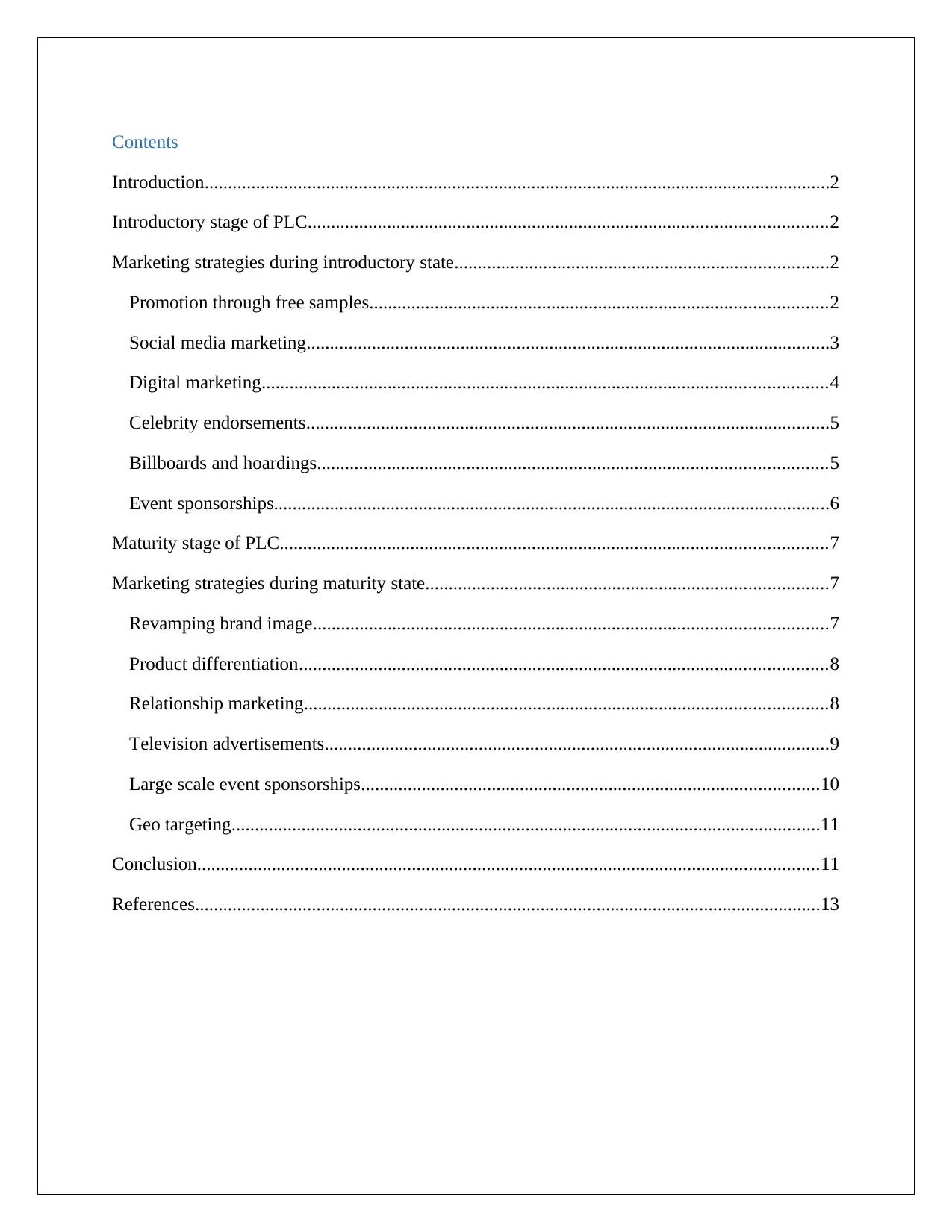
Contents
Introduction......................................................................................................................................2
Introductory stage of PLC...............................................................................................................2
Marketing strategies during introductory state................................................................................2
Promotion through free samples..................................................................................................2
Social media marketing................................................................................................................3
Digital marketing.........................................................................................................................4
Celebrity endorsements................................................................................................................5
Billboards and hoardings.............................................................................................................5
Event sponsorships.......................................................................................................................6
Maturity stage of PLC.....................................................................................................................7
Marketing strategies during maturity state......................................................................................7
Revamping brand image..............................................................................................................7
Product differentiation.................................................................................................................8
Relationship marketing................................................................................................................8
Television advertisements............................................................................................................9
Large scale event sponsorships..................................................................................................10
Geo targeting..............................................................................................................................11
Conclusion.....................................................................................................................................11
References......................................................................................................................................13
Introduction......................................................................................................................................2
Introductory stage of PLC...............................................................................................................2
Marketing strategies during introductory state................................................................................2
Promotion through free samples..................................................................................................2
Social media marketing................................................................................................................3
Digital marketing.........................................................................................................................4
Celebrity endorsements................................................................................................................5
Billboards and hoardings.............................................................................................................5
Event sponsorships.......................................................................................................................6
Maturity stage of PLC.....................................................................................................................7
Marketing strategies during maturity state......................................................................................7
Revamping brand image..............................................................................................................7
Product differentiation.................................................................................................................8
Relationship marketing................................................................................................................8
Television advertisements............................................................................................................9
Large scale event sponsorships..................................................................................................10
Geo targeting..............................................................................................................................11
Conclusion.....................................................................................................................................11
References......................................................................................................................................13
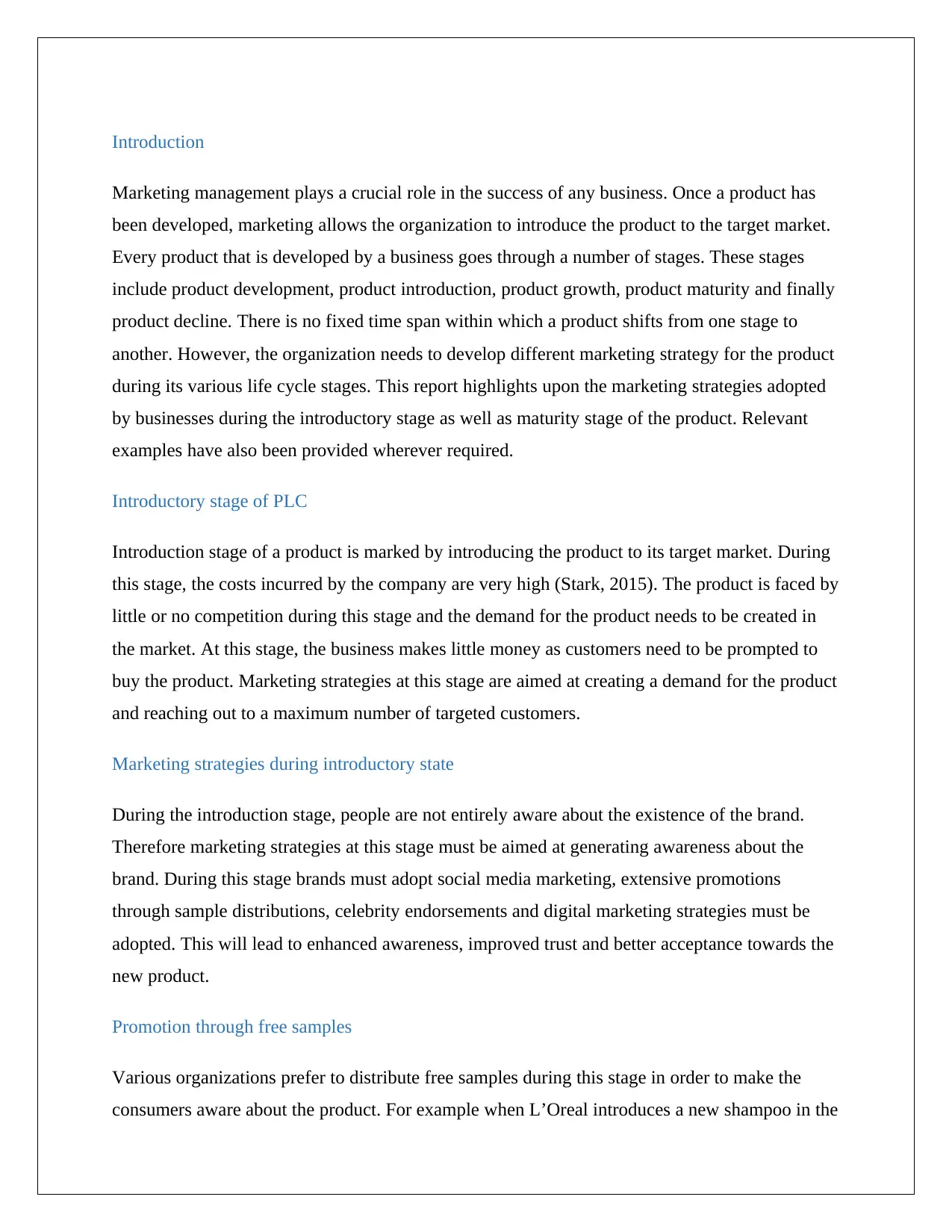
Introduction
Marketing management plays a crucial role in the success of any business. Once a product has
been developed, marketing allows the organization to introduce the product to the target market.
Every product that is developed by a business goes through a number of stages. These stages
include product development, product introduction, product growth, product maturity and finally
product decline. There is no fixed time span within which a product shifts from one stage to
another. However, the organization needs to develop different marketing strategy for the product
during its various life cycle stages. This report highlights upon the marketing strategies adopted
by businesses during the introductory stage as well as maturity stage of the product. Relevant
examples have also been provided wherever required.
Introductory stage of PLC
Introduction stage of a product is marked by introducing the product to its target market. During
this stage, the costs incurred by the company are very high (Stark, 2015). The product is faced by
little or no competition during this stage and the demand for the product needs to be created in
the market. At this stage, the business makes little money as customers need to be prompted to
buy the product. Marketing strategies at this stage are aimed at creating a demand for the product
and reaching out to a maximum number of targeted customers.
Marketing strategies during introductory state
During the introduction stage, people are not entirely aware about the existence of the brand.
Therefore marketing strategies at this stage must be aimed at generating awareness about the
brand. During this stage brands must adopt social media marketing, extensive promotions
through sample distributions, celebrity endorsements and digital marketing strategies must be
adopted. This will lead to enhanced awareness, improved trust and better acceptance towards the
new product.
Promotion through free samples
Various organizations prefer to distribute free samples during this stage in order to make the
consumers aware about the product. For example when L’Oreal introduces a new shampoo in the
Marketing management plays a crucial role in the success of any business. Once a product has
been developed, marketing allows the organization to introduce the product to the target market.
Every product that is developed by a business goes through a number of stages. These stages
include product development, product introduction, product growth, product maturity and finally
product decline. There is no fixed time span within which a product shifts from one stage to
another. However, the organization needs to develop different marketing strategy for the product
during its various life cycle stages. This report highlights upon the marketing strategies adopted
by businesses during the introductory stage as well as maturity stage of the product. Relevant
examples have also been provided wherever required.
Introductory stage of PLC
Introduction stage of a product is marked by introducing the product to its target market. During
this stage, the costs incurred by the company are very high (Stark, 2015). The product is faced by
little or no competition during this stage and the demand for the product needs to be created in
the market. At this stage, the business makes little money as customers need to be prompted to
buy the product. Marketing strategies at this stage are aimed at creating a demand for the product
and reaching out to a maximum number of targeted customers.
Marketing strategies during introductory state
During the introduction stage, people are not entirely aware about the existence of the brand.
Therefore marketing strategies at this stage must be aimed at generating awareness about the
brand. During this stage brands must adopt social media marketing, extensive promotions
through sample distributions, celebrity endorsements and digital marketing strategies must be
adopted. This will lead to enhanced awareness, improved trust and better acceptance towards the
new product.
Promotion through free samples
Various organizations prefer to distribute free samples during this stage in order to make the
consumers aware about the product. For example when L’Oreal introduces a new shampoo in the
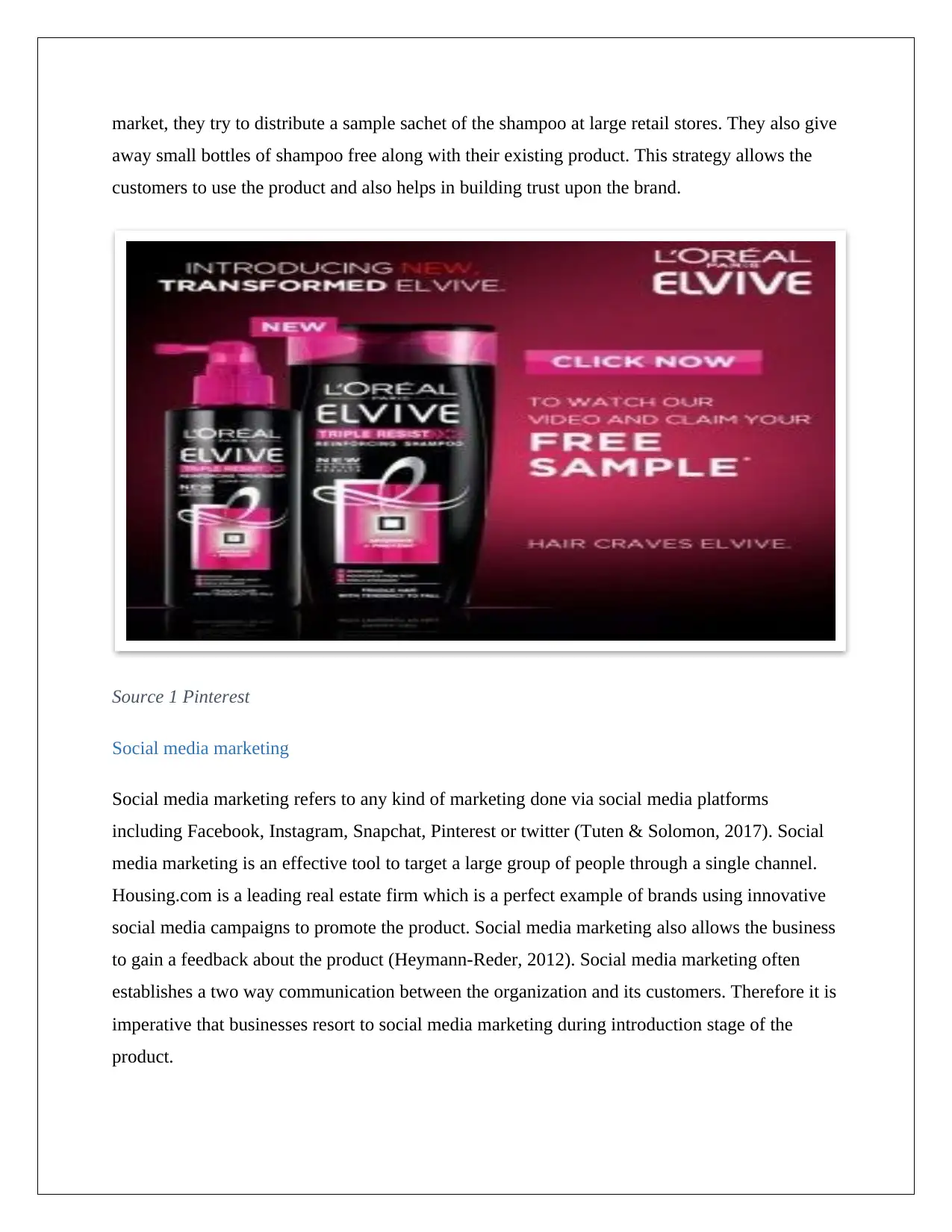
market, they try to distribute a sample sachet of the shampoo at large retail stores. They also give
away small bottles of shampoo free along with their existing product. This strategy allows the
customers to use the product and also helps in building trust upon the brand.
Source 1 Pinterest
Social media marketing
Social media marketing refers to any kind of marketing done via social media platforms
including Facebook, Instagram, Snapchat, Pinterest or twitter (Tuten & Solomon, 2017). Social
media marketing is an effective tool to target a large group of people through a single channel.
Housing.com is a leading real estate firm which is a perfect example of brands using innovative
social media campaigns to promote the product. Social media marketing also allows the business
to gain a feedback about the product (Heymann-Reder, 2012). Social media marketing often
establishes a two way communication between the organization and its customers. Therefore it is
imperative that businesses resort to social media marketing during introduction stage of the
product.
away small bottles of shampoo free along with their existing product. This strategy allows the
customers to use the product and also helps in building trust upon the brand.
Source 1 Pinterest
Social media marketing
Social media marketing refers to any kind of marketing done via social media platforms
including Facebook, Instagram, Snapchat, Pinterest or twitter (Tuten & Solomon, 2017). Social
media marketing is an effective tool to target a large group of people through a single channel.
Housing.com is a leading real estate firm which is a perfect example of brands using innovative
social media campaigns to promote the product. Social media marketing also allows the business
to gain a feedback about the product (Heymann-Reder, 2012). Social media marketing often
establishes a two way communication between the organization and its customers. Therefore it is
imperative that businesses resort to social media marketing during introduction stage of the
product.
Secure Best Marks with AI Grader
Need help grading? Try our AI Grader for instant feedback on your assignments.
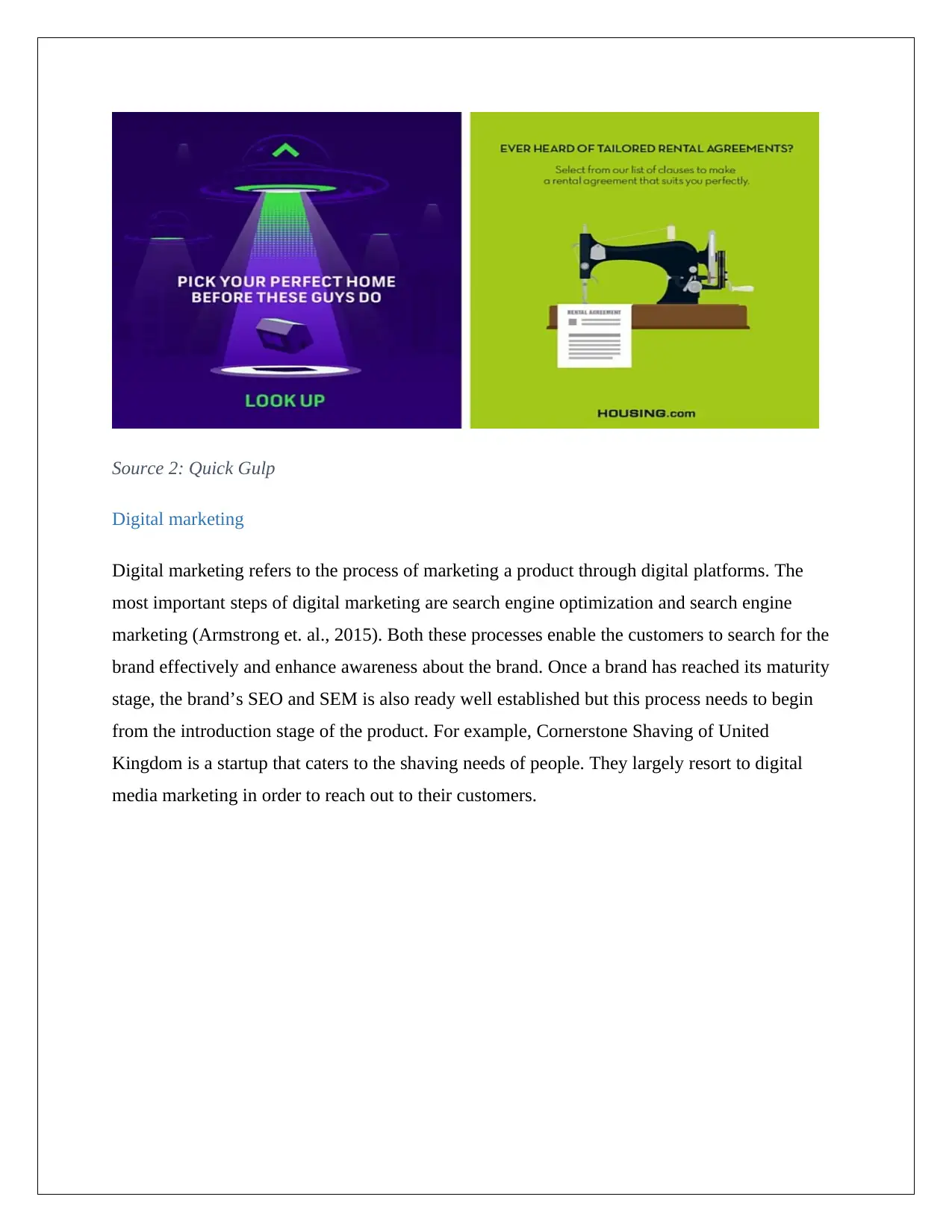
Source 2: Quick Gulp
Digital marketing
Digital marketing refers to the process of marketing a product through digital platforms. The
most important steps of digital marketing are search engine optimization and search engine
marketing (Armstrong et. al., 2015). Both these processes enable the customers to search for the
brand effectively and enhance awareness about the brand. Once a brand has reached its maturity
stage, the brand’s SEO and SEM is also ready well established but this process needs to begin
from the introduction stage of the product. For example, Cornerstone Shaving of United
Kingdom is a startup that caters to the shaving needs of people. They largely resort to digital
media marketing in order to reach out to their customers.
Digital marketing
Digital marketing refers to the process of marketing a product through digital platforms. The
most important steps of digital marketing are search engine optimization and search engine
marketing (Armstrong et. al., 2015). Both these processes enable the customers to search for the
brand effectively and enhance awareness about the brand. Once a brand has reached its maturity
stage, the brand’s SEO and SEM is also ready well established but this process needs to begin
from the introduction stage of the product. For example, Cornerstone Shaving of United
Kingdom is a startup that caters to the shaving needs of people. They largely resort to digital
media marketing in order to reach out to their customers.
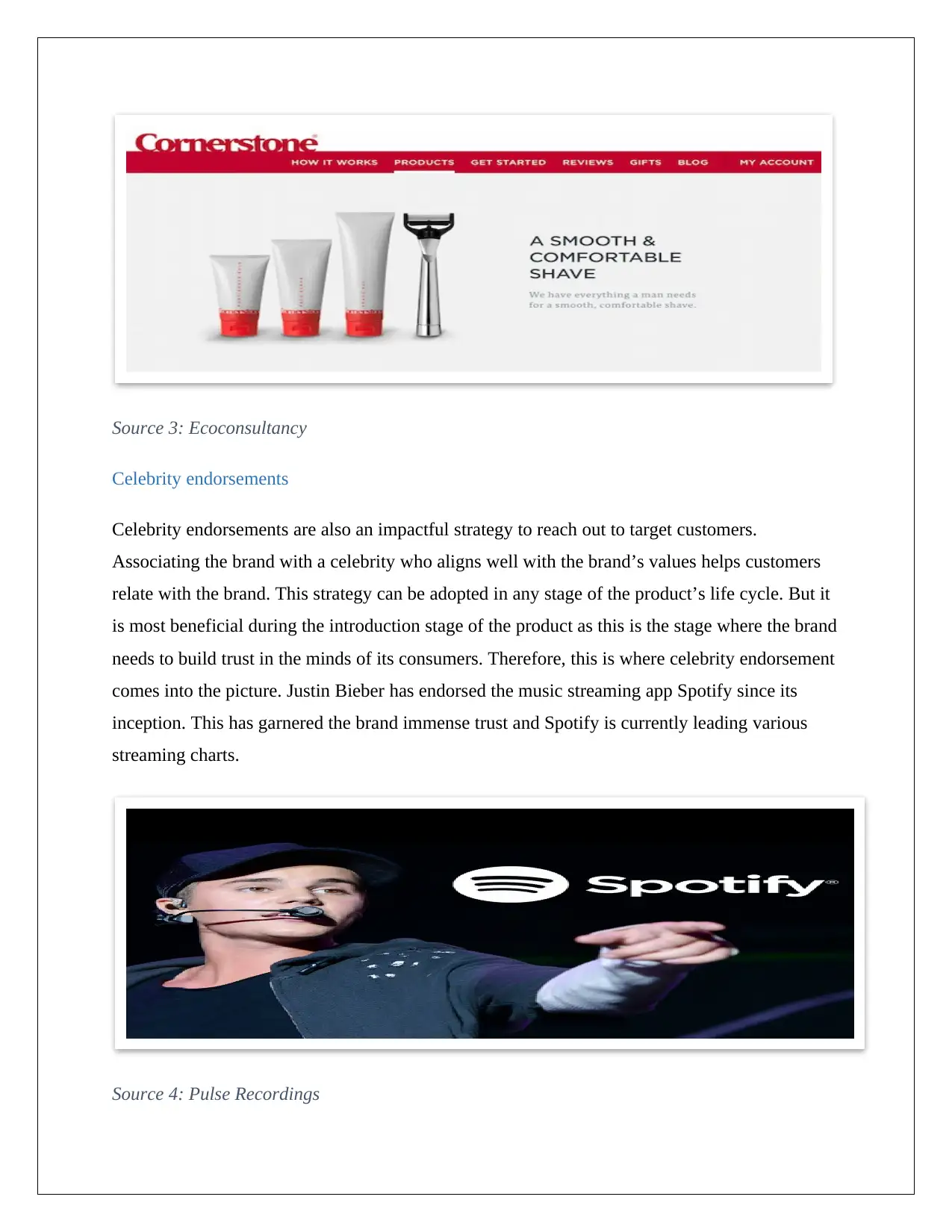
Source 3: Ecoconsultancy
Celebrity endorsements
Celebrity endorsements are also an impactful strategy to reach out to target customers.
Associating the brand with a celebrity who aligns well with the brand’s values helps customers
relate with the brand. This strategy can be adopted in any stage of the product’s life cycle. But it
is most beneficial during the introduction stage of the product as this is the stage where the brand
needs to build trust in the minds of its consumers. Therefore, this is where celebrity endorsement
comes into the picture. Justin Bieber has endorsed the music streaming app Spotify since its
inception. This has garnered the brand immense trust and Spotify is currently leading various
streaming charts.
Source 4: Pulse Recordings
Celebrity endorsements
Celebrity endorsements are also an impactful strategy to reach out to target customers.
Associating the brand with a celebrity who aligns well with the brand’s values helps customers
relate with the brand. This strategy can be adopted in any stage of the product’s life cycle. But it
is most beneficial during the introduction stage of the product as this is the stage where the brand
needs to build trust in the minds of its consumers. Therefore, this is where celebrity endorsement
comes into the picture. Justin Bieber has endorsed the music streaming app Spotify since its
inception. This has garnered the brand immense trust and Spotify is currently leading various
streaming charts.
Source 4: Pulse Recordings
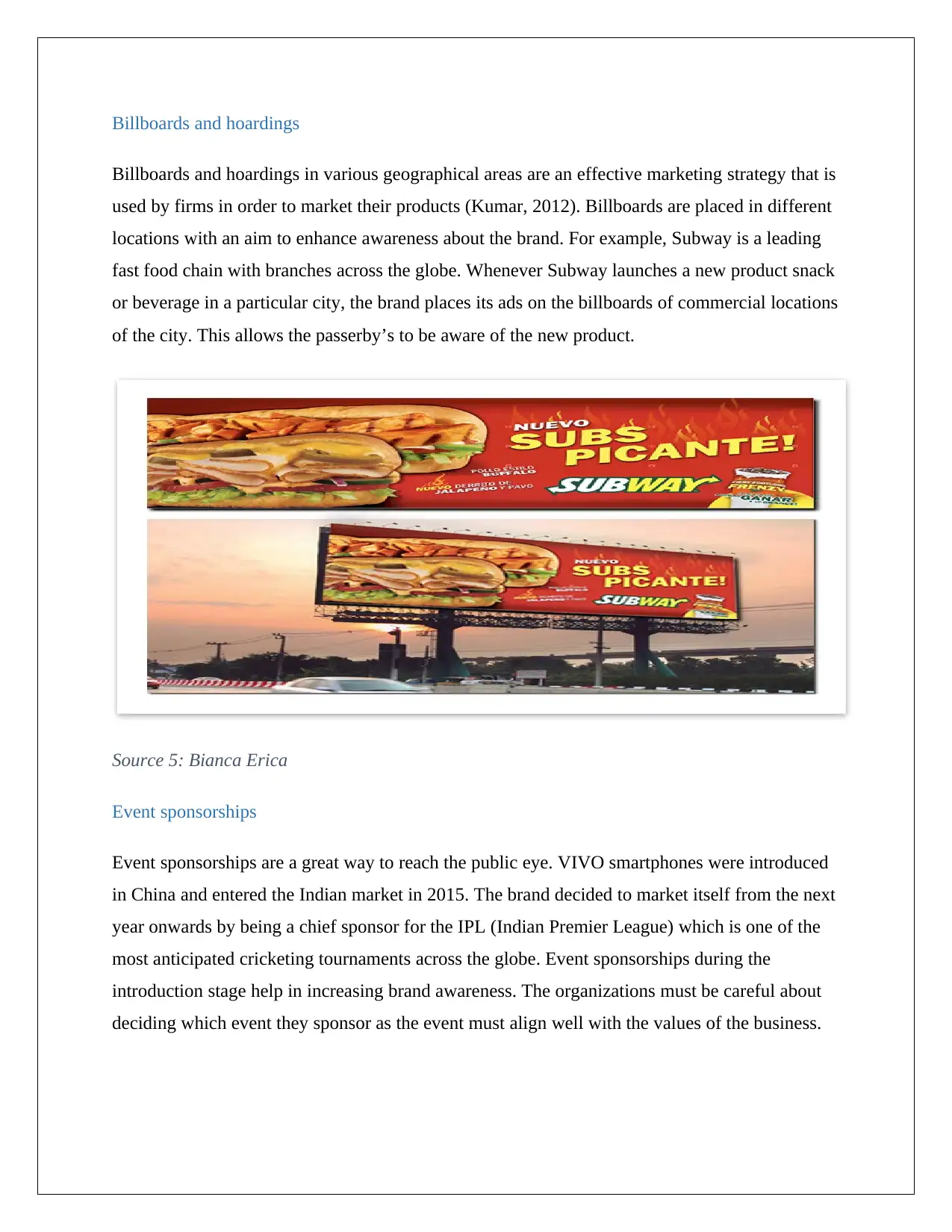
Billboards and hoardings
Billboards and hoardings in various geographical areas are an effective marketing strategy that is
used by firms in order to market their products (Kumar, 2012). Billboards are placed in different
locations with an aim to enhance awareness about the brand. For example, Subway is a leading
fast food chain with branches across the globe. Whenever Subway launches a new product snack
or beverage in a particular city, the brand places its ads on the billboards of commercial locations
of the city. This allows the passerby’s to be aware of the new product.
Source 5: Bianca Erica
Event sponsorships
Event sponsorships are a great way to reach the public eye. VIVO smartphones were introduced
in China and entered the Indian market in 2015. The brand decided to market itself from the next
year onwards by being a chief sponsor for the IPL (Indian Premier League) which is one of the
most anticipated cricketing tournaments across the globe. Event sponsorships during the
introduction stage help in increasing brand awareness. The organizations must be careful about
deciding which event they sponsor as the event must align well with the values of the business.
Billboards and hoardings in various geographical areas are an effective marketing strategy that is
used by firms in order to market their products (Kumar, 2012). Billboards are placed in different
locations with an aim to enhance awareness about the brand. For example, Subway is a leading
fast food chain with branches across the globe. Whenever Subway launches a new product snack
or beverage in a particular city, the brand places its ads on the billboards of commercial locations
of the city. This allows the passerby’s to be aware of the new product.
Source 5: Bianca Erica
Event sponsorships
Event sponsorships are a great way to reach the public eye. VIVO smartphones were introduced
in China and entered the Indian market in 2015. The brand decided to market itself from the next
year onwards by being a chief sponsor for the IPL (Indian Premier League) which is one of the
most anticipated cricketing tournaments across the globe. Event sponsorships during the
introduction stage help in increasing brand awareness. The organizations must be careful about
deciding which event they sponsor as the event must align well with the values of the business.
Paraphrase This Document
Need a fresh take? Get an instant paraphrase of this document with our AI Paraphraser
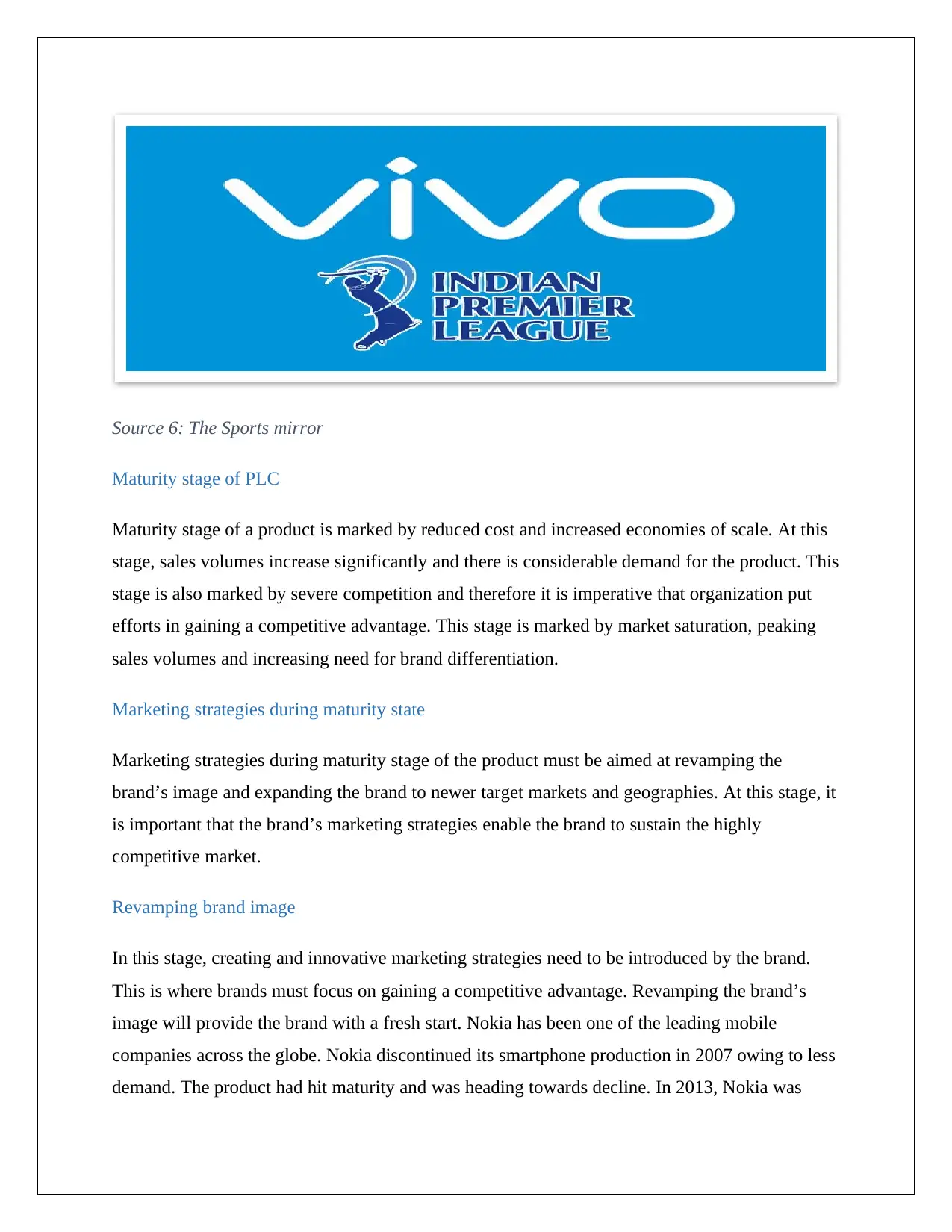
Source 6: The Sports mirror
Maturity stage of PLC
Maturity stage of a product is marked by reduced cost and increased economies of scale. At this
stage, sales volumes increase significantly and there is considerable demand for the product. This
stage is also marked by severe competition and therefore it is imperative that organization put
efforts in gaining a competitive advantage. This stage is marked by market saturation, peaking
sales volumes and increasing need for brand differentiation.
Marketing strategies during maturity state
Marketing strategies during maturity stage of the product must be aimed at revamping the
brand’s image and expanding the brand to newer target markets and geographies. At this stage, it
is important that the brand’s marketing strategies enable the brand to sustain the highly
competitive market.
Revamping brand image
In this stage, creating and innovative marketing strategies need to be introduced by the brand.
This is where brands must focus on gaining a competitive advantage. Revamping the brand’s
image will provide the brand with a fresh start. Nokia has been one of the leading mobile
companies across the globe. Nokia discontinued its smartphone production in 2007 owing to less
demand. The product had hit maturity and was heading towards decline. In 2013, Nokia was
Maturity stage of PLC
Maturity stage of a product is marked by reduced cost and increased economies of scale. At this
stage, sales volumes increase significantly and there is considerable demand for the product. This
stage is also marked by severe competition and therefore it is imperative that organization put
efforts in gaining a competitive advantage. This stage is marked by market saturation, peaking
sales volumes and increasing need for brand differentiation.
Marketing strategies during maturity state
Marketing strategies during maturity stage of the product must be aimed at revamping the
brand’s image and expanding the brand to newer target markets and geographies. At this stage, it
is important that the brand’s marketing strategies enable the brand to sustain the highly
competitive market.
Revamping brand image
In this stage, creating and innovative marketing strategies need to be introduced by the brand.
This is where brands must focus on gaining a competitive advantage. Revamping the brand’s
image will provide the brand with a fresh start. Nokia has been one of the leading mobile
companies across the globe. Nokia discontinued its smartphone production in 2007 owing to less
demand. The product had hit maturity and was heading towards decline. In 2013, Nokia was
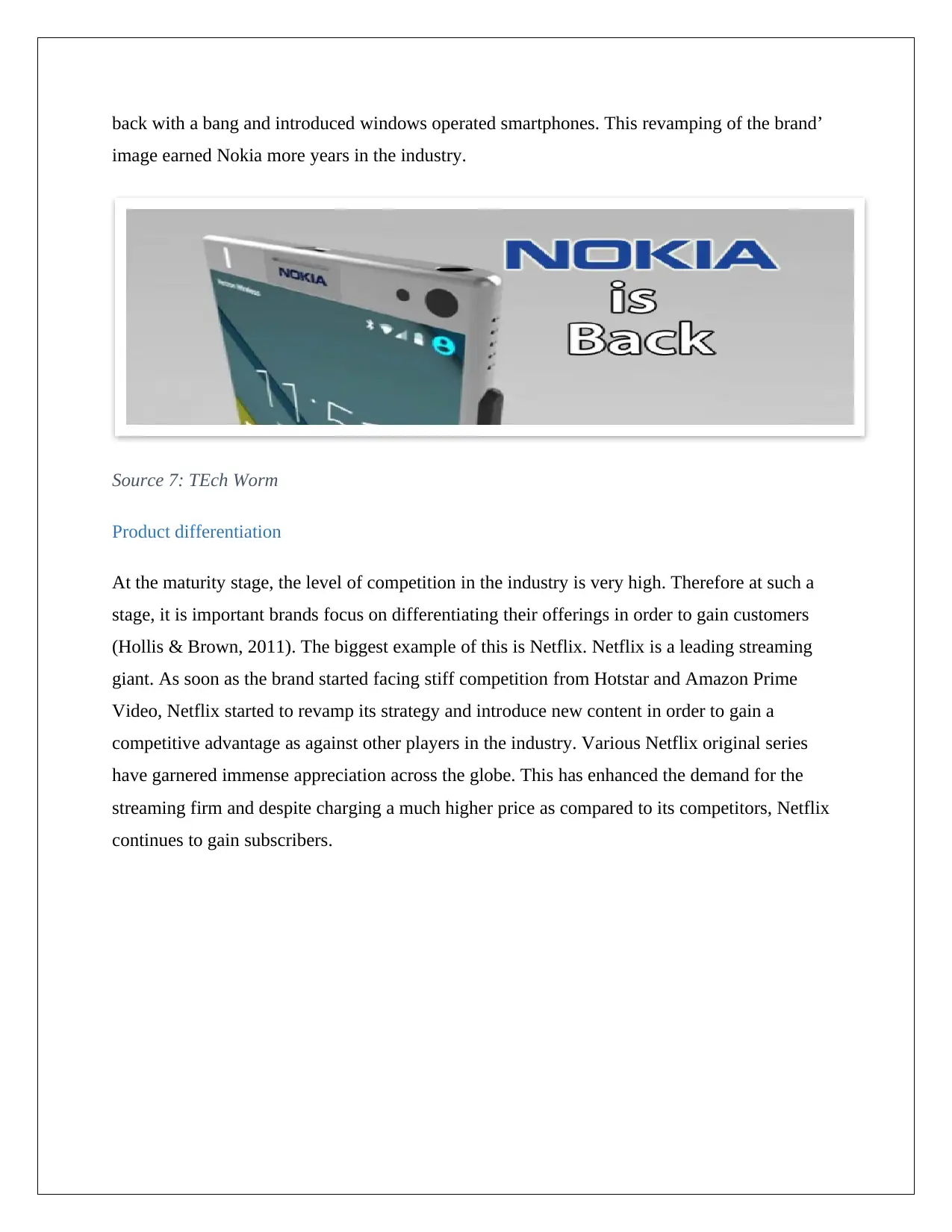
back with a bang and introduced windows operated smartphones. This revamping of the brand’
image earned Nokia more years in the industry.
Source 7: TEch Worm
Product differentiation
At the maturity stage, the level of competition in the industry is very high. Therefore at such a
stage, it is important brands focus on differentiating their offerings in order to gain customers
(Hollis & Brown, 2011). The biggest example of this is Netflix. Netflix is a leading streaming
giant. As soon as the brand started facing stiff competition from Hotstar and Amazon Prime
Video, Netflix started to revamp its strategy and introduce new content in order to gain a
competitive advantage as against other players in the industry. Various Netflix original series
have garnered immense appreciation across the globe. This has enhanced the demand for the
streaming firm and despite charging a much higher price as compared to its competitors, Netflix
continues to gain subscribers.
image earned Nokia more years in the industry.
Source 7: TEch Worm
Product differentiation
At the maturity stage, the level of competition in the industry is very high. Therefore at such a
stage, it is important brands focus on differentiating their offerings in order to gain customers
(Hollis & Brown, 2011). The biggest example of this is Netflix. Netflix is a leading streaming
giant. As soon as the brand started facing stiff competition from Hotstar and Amazon Prime
Video, Netflix started to revamp its strategy and introduce new content in order to gain a
competitive advantage as against other players in the industry. Various Netflix original series
have garnered immense appreciation across the globe. This has enhanced the demand for the
streaming firm and despite charging a much higher price as compared to its competitors, Netflix
continues to gain subscribers.
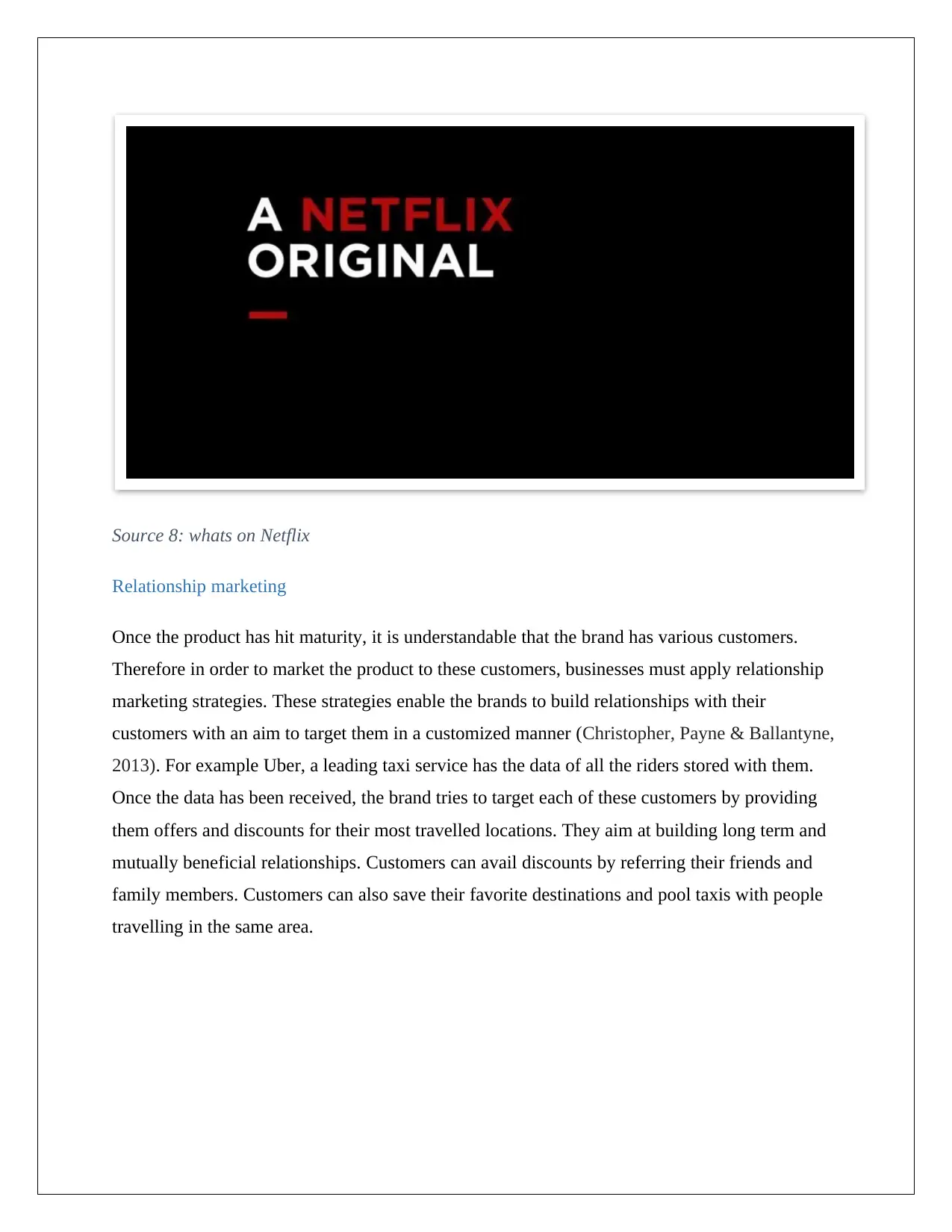
Source 8: whats on Netflix
Relationship marketing
Once the product has hit maturity, it is understandable that the brand has various customers.
Therefore in order to market the product to these customers, businesses must apply relationship
marketing strategies. These strategies enable the brands to build relationships with their
customers with an aim to target them in a customized manner (Christopher, Payne & Ballantyne,
2013). For example Uber, a leading taxi service has the data of all the riders stored with them.
Once the data has been received, the brand tries to target each of these customers by providing
them offers and discounts for their most travelled locations. They aim at building long term and
mutually beneficial relationships. Customers can avail discounts by referring their friends and
family members. Customers can also save their favorite destinations and pool taxis with people
travelling in the same area.
Relationship marketing
Once the product has hit maturity, it is understandable that the brand has various customers.
Therefore in order to market the product to these customers, businesses must apply relationship
marketing strategies. These strategies enable the brands to build relationships with their
customers with an aim to target them in a customized manner (Christopher, Payne & Ballantyne,
2013). For example Uber, a leading taxi service has the data of all the riders stored with them.
Once the data has been received, the brand tries to target each of these customers by providing
them offers and discounts for their most travelled locations. They aim at building long term and
mutually beneficial relationships. Customers can avail discounts by referring their friends and
family members. Customers can also save their favorite destinations and pool taxis with people
travelling in the same area.
Secure Best Marks with AI Grader
Need help grading? Try our AI Grader for instant feedback on your assignments.
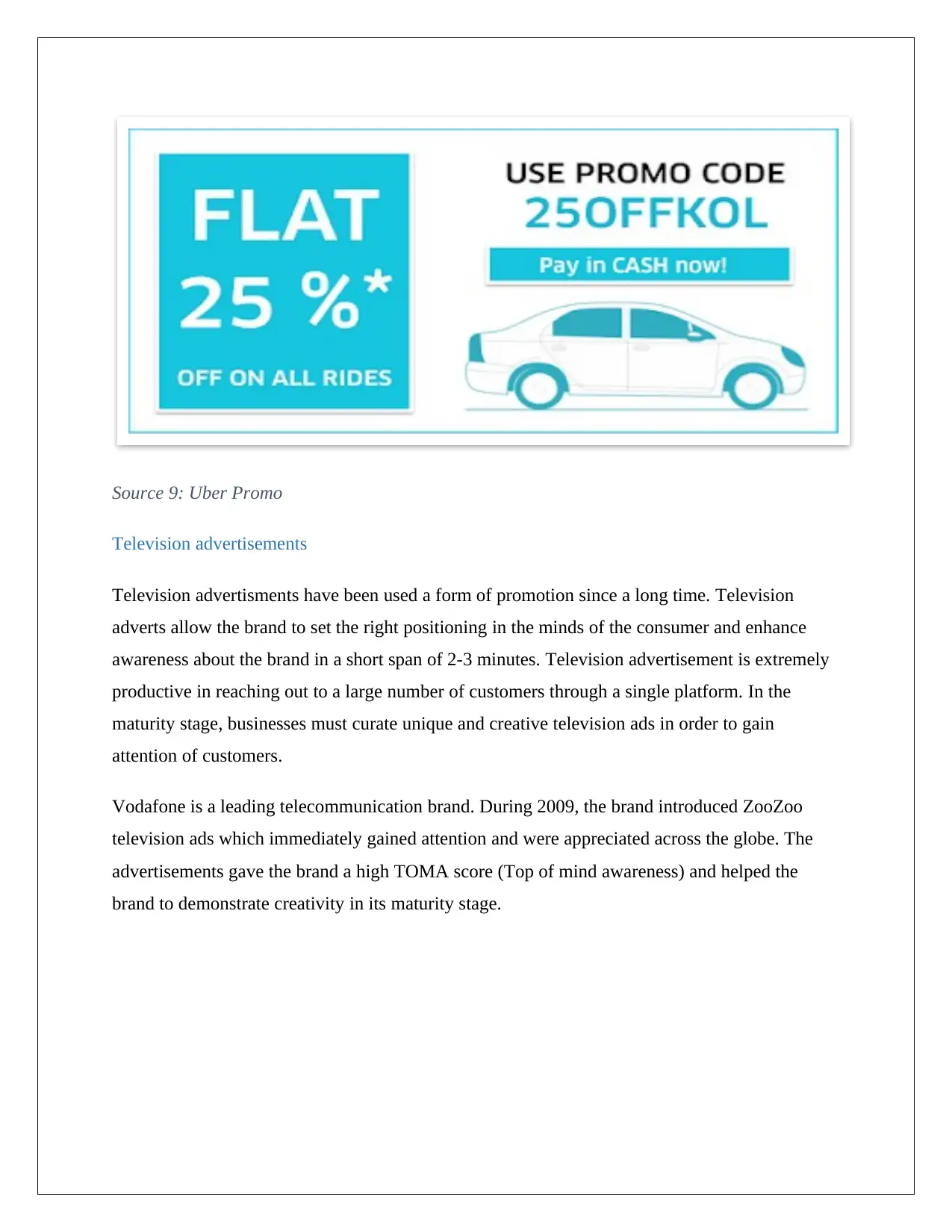
Source 9: Uber Promo
Television advertisements
Television advertisments have been used a form of promotion since a long time. Television
adverts allow the brand to set the right positioning in the minds of the consumer and enhance
awareness about the brand in a short span of 2-3 minutes. Television advertisement is extremely
productive in reaching out to a large number of customers through a single platform. In the
maturity stage, businesses must curate unique and creative television ads in order to gain
attention of customers.
Vodafone is a leading telecommunication brand. During 2009, the brand introduced ZooZoo
television ads which immediately gained attention and were appreciated across the globe. The
advertisements gave the brand a high TOMA score (Top of mind awareness) and helped the
brand to demonstrate creativity in its maturity stage.
Television advertisements
Television advertisments have been used a form of promotion since a long time. Television
adverts allow the brand to set the right positioning in the minds of the consumer and enhance
awareness about the brand in a short span of 2-3 minutes. Television advertisement is extremely
productive in reaching out to a large number of customers through a single platform. In the
maturity stage, businesses must curate unique and creative television ads in order to gain
attention of customers.
Vodafone is a leading telecommunication brand. During 2009, the brand introduced ZooZoo
television ads which immediately gained attention and were appreciated across the globe. The
advertisements gave the brand a high TOMA score (Top of mind awareness) and helped the
brand to demonstrate creativity in its maturity stage.
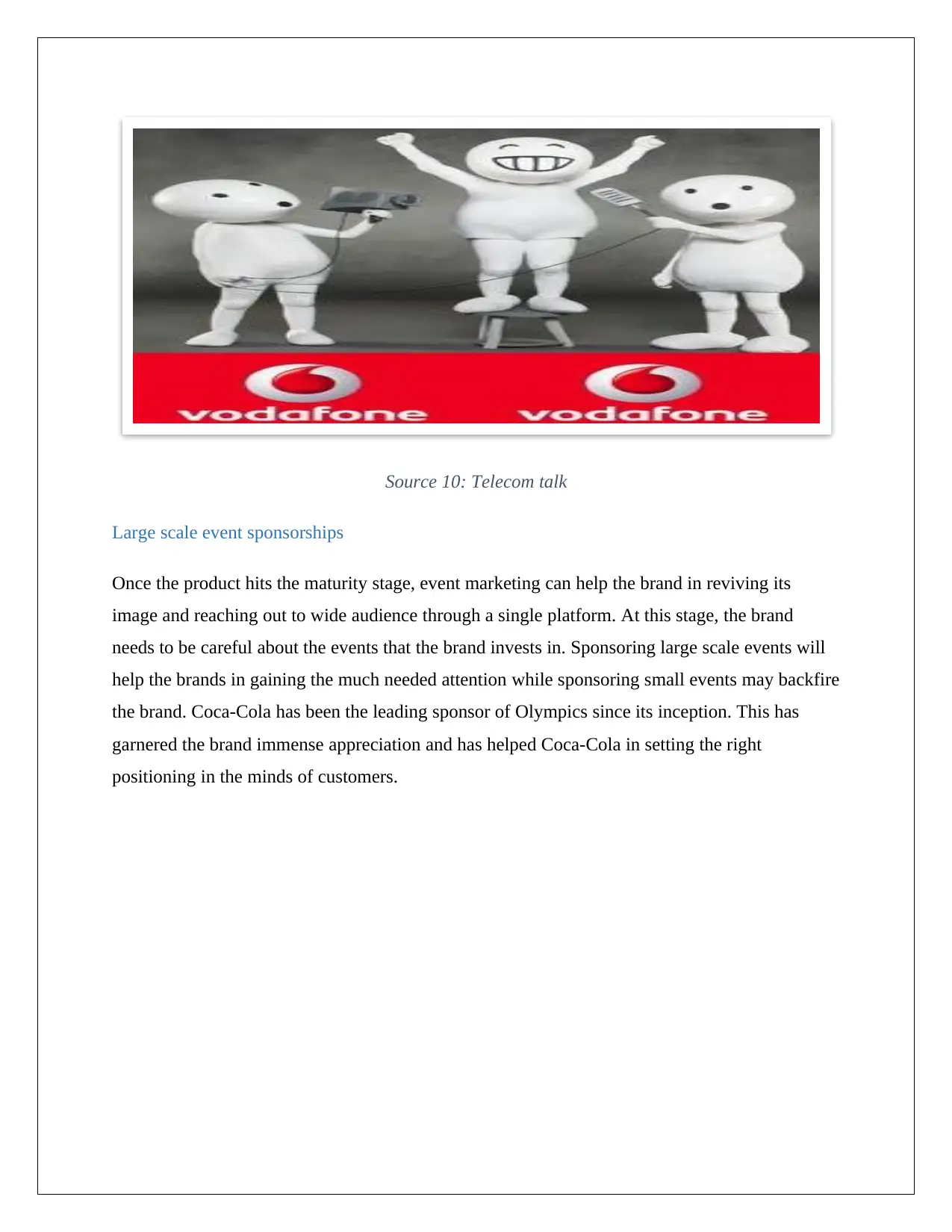
Source 10: Telecom talk
Large scale event sponsorships
Once the product hits the maturity stage, event marketing can help the brand in reviving its
image and reaching out to wide audience through a single platform. At this stage, the brand
needs to be careful about the events that the brand invests in. Sponsoring large scale events will
help the brands in gaining the much needed attention while sponsoring small events may backfire
the brand. Coca-Cola has been the leading sponsor of Olympics since its inception. This has
garnered the brand immense appreciation and has helped Coca-Cola in setting the right
positioning in the minds of customers.
Large scale event sponsorships
Once the product hits the maturity stage, event marketing can help the brand in reviving its
image and reaching out to wide audience through a single platform. At this stage, the brand
needs to be careful about the events that the brand invests in. Sponsoring large scale events will
help the brands in gaining the much needed attention while sponsoring small events may backfire
the brand. Coca-Cola has been the leading sponsor of Olympics since its inception. This has
garnered the brand immense appreciation and has helped Coca-Cola in setting the right
positioning in the minds of customers.
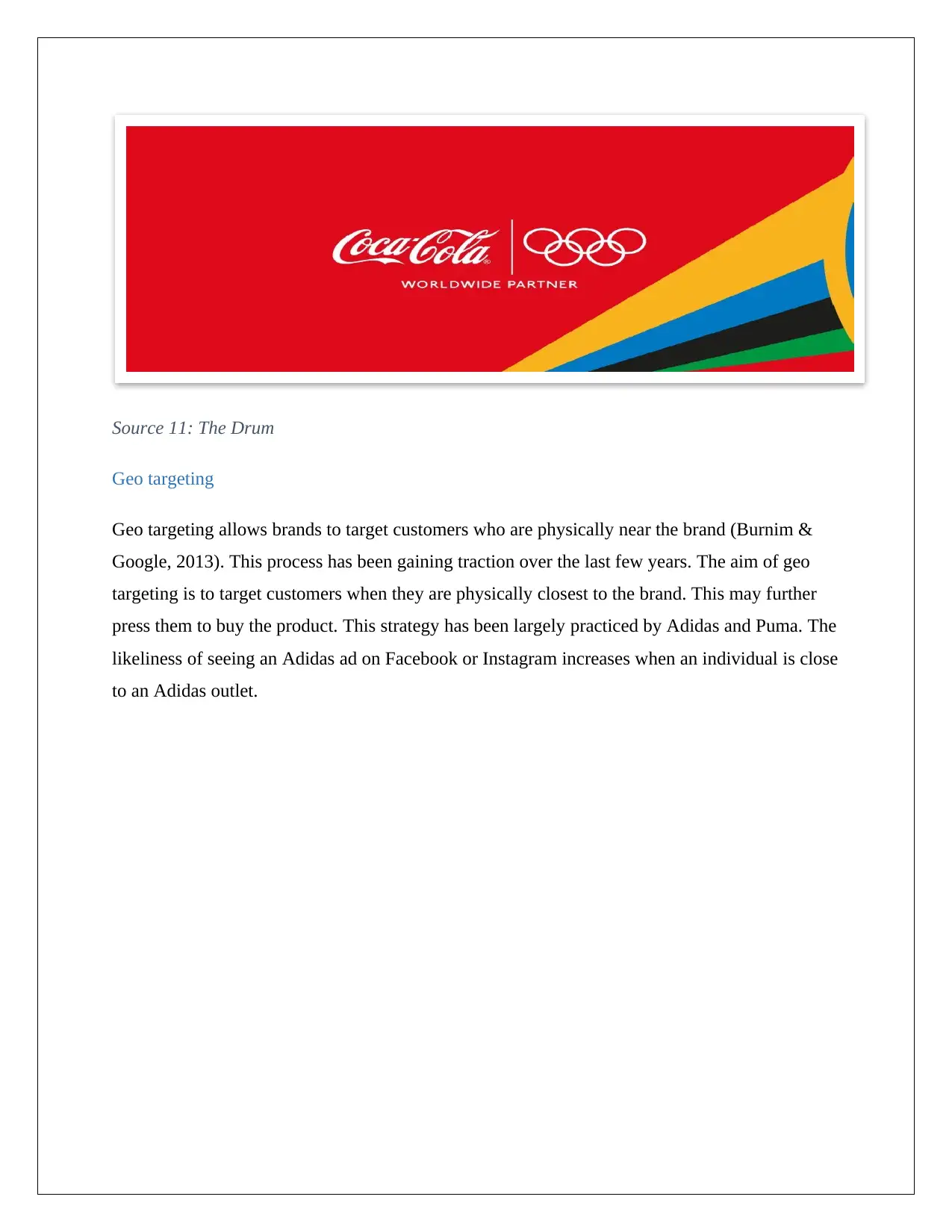
Source 11: The Drum
Geo targeting
Geo targeting allows brands to target customers who are physically near the brand (Burnim &
Google, 2013). This process has been gaining traction over the last few years. The aim of geo
targeting is to target customers when they are physically closest to the brand. This may further
press them to buy the product. This strategy has been largely practiced by Adidas and Puma. The
likeliness of seeing an Adidas ad on Facebook or Instagram increases when an individual is close
to an Adidas outlet.
Geo targeting
Geo targeting allows brands to target customers who are physically near the brand (Burnim &
Google, 2013). This process has been gaining traction over the last few years. The aim of geo
targeting is to target customers when they are physically closest to the brand. This may further
press them to buy the product. This strategy has been largely practiced by Adidas and Puma. The
likeliness of seeing an Adidas ad on Facebook or Instagram increases when an individual is close
to an Adidas outlet.
Paraphrase This Document
Need a fresh take? Get an instant paraphrase of this document with our AI Paraphraser
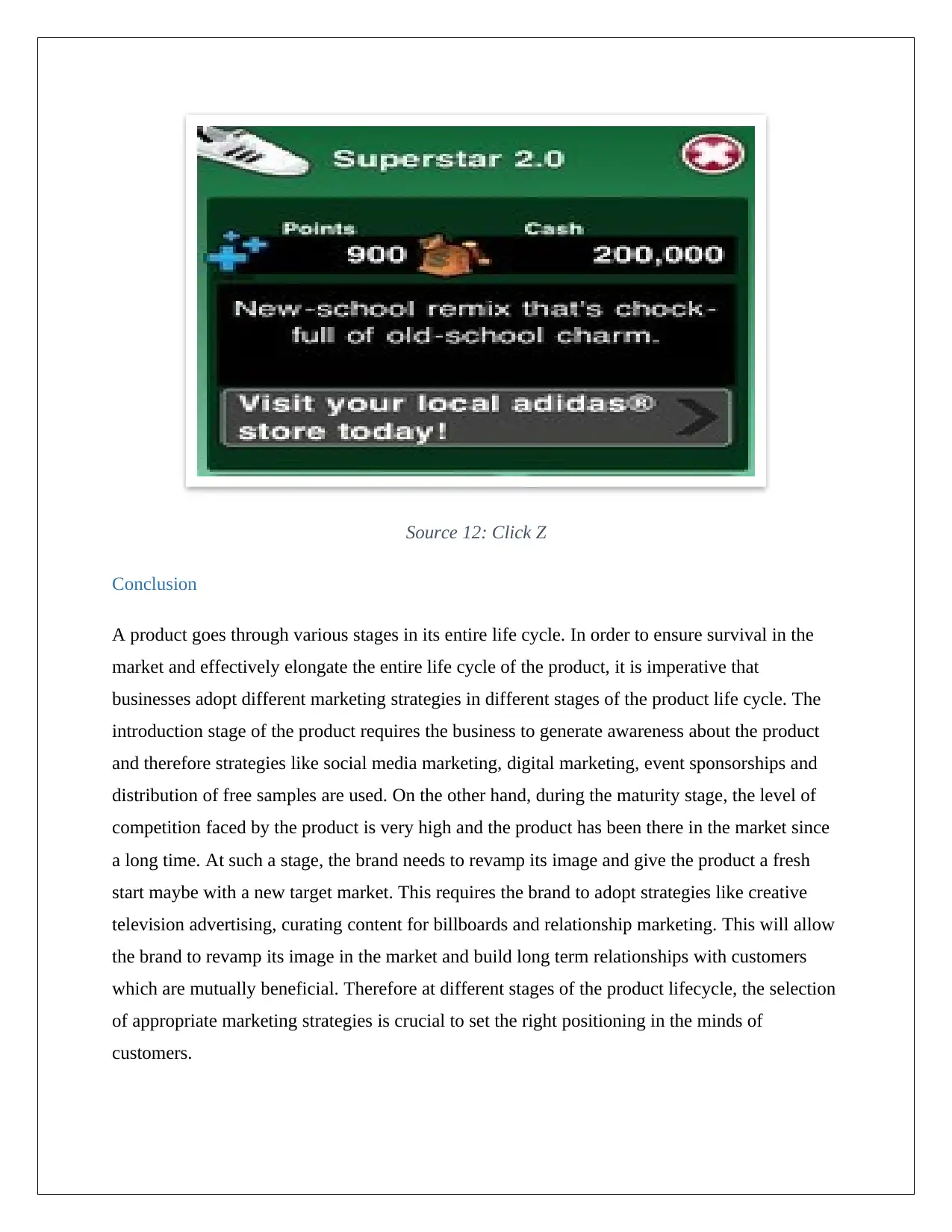
Source 12: Click Z
Conclusion
A product goes through various stages in its entire life cycle. In order to ensure survival in the
market and effectively elongate the entire life cycle of the product, it is imperative that
businesses adopt different marketing strategies in different stages of the product life cycle. The
introduction stage of the product requires the business to generate awareness about the product
and therefore strategies like social media marketing, digital marketing, event sponsorships and
distribution of free samples are used. On the other hand, during the maturity stage, the level of
competition faced by the product is very high and the product has been there in the market since
a long time. At such a stage, the brand needs to revamp its image and give the product a fresh
start maybe with a new target market. This requires the brand to adopt strategies like creative
television advertising, curating content for billboards and relationship marketing. This will allow
the brand to revamp its image in the market and build long term relationships with customers
which are mutually beneficial. Therefore at different stages of the product lifecycle, the selection
of appropriate marketing strategies is crucial to set the right positioning in the minds of
customers.
Conclusion
A product goes through various stages in its entire life cycle. In order to ensure survival in the
market and effectively elongate the entire life cycle of the product, it is imperative that
businesses adopt different marketing strategies in different stages of the product life cycle. The
introduction stage of the product requires the business to generate awareness about the product
and therefore strategies like social media marketing, digital marketing, event sponsorships and
distribution of free samples are used. On the other hand, during the maturity stage, the level of
competition faced by the product is very high and the product has been there in the market since
a long time. At such a stage, the brand needs to revamp its image and give the product a fresh
start maybe with a new target market. This requires the brand to adopt strategies like creative
television advertising, curating content for billboards and relationship marketing. This will allow
the brand to revamp its image in the market and build long term relationships with customers
which are mutually beneficial. Therefore at different stages of the product lifecycle, the selection
of appropriate marketing strategies is crucial to set the right positioning in the minds of
customers.
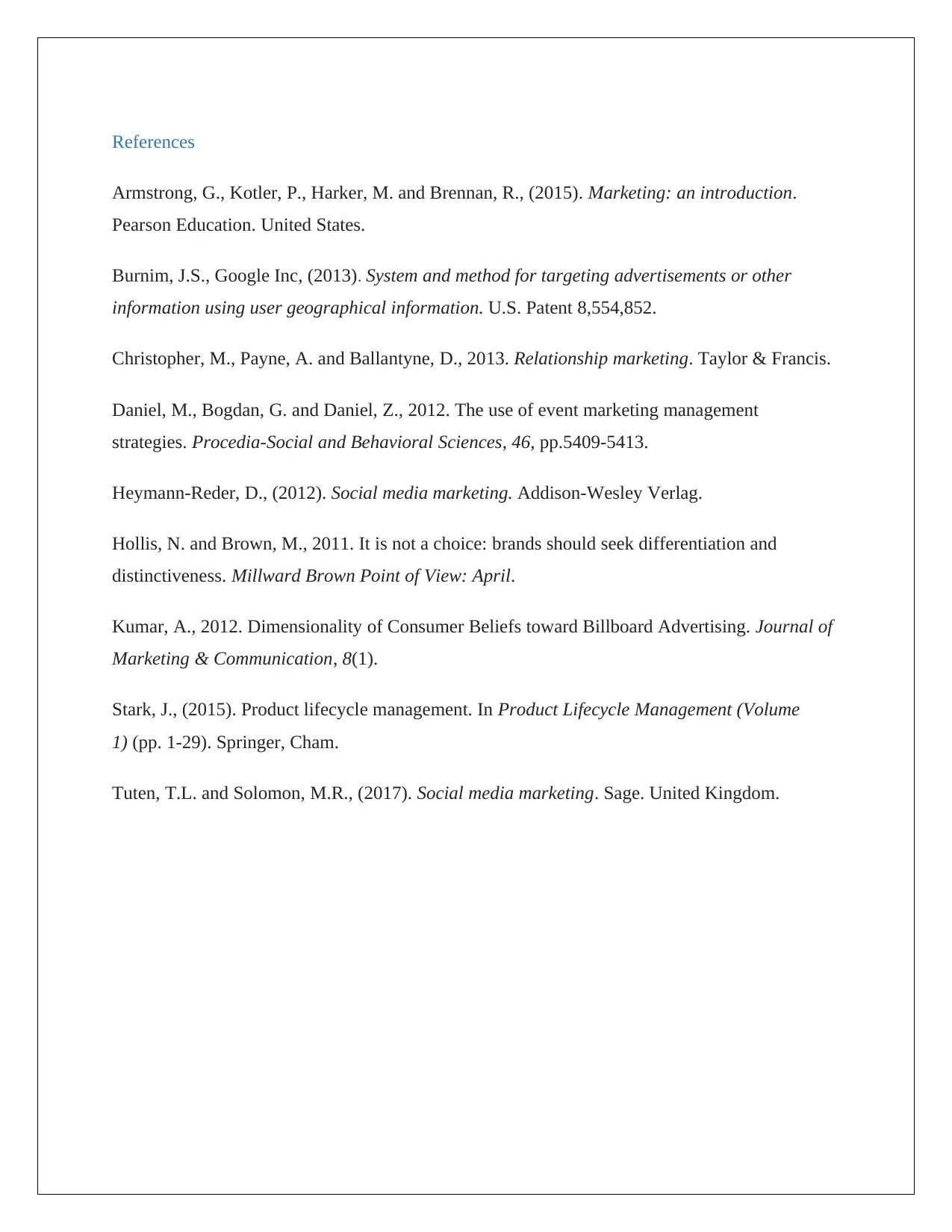
References
Armstrong, G., Kotler, P., Harker, M. and Brennan, R., (2015). Marketing: an introduction.
Pearson Education. United States.
Burnim, J.S., Google Inc, (2013). System and method for targeting advertisements or other
information using user geographical information. U.S. Patent 8,554,852.
Christopher, M., Payne, A. and Ballantyne, D., 2013. Relationship marketing. Taylor & Francis.
Daniel, M., Bogdan, G. and Daniel, Z., 2012. The use of event marketing management
strategies. Procedia-Social and Behavioral Sciences, 46, pp.5409-5413.
Heymann-Reder, D., (2012). Social media marketing. Addison-Wesley Verlag.
Hollis, N. and Brown, M., 2011. It is not a choice: brands should seek differentiation and
distinctiveness. Millward Brown Point of View: April.
Kumar, A., 2012. Dimensionality of Consumer Beliefs toward Billboard Advertising. Journal of
Marketing & Communication, 8(1).
Stark, J., (2015). Product lifecycle management. In Product Lifecycle Management (Volume
1) (pp. 1-29). Springer, Cham.
Tuten, T.L. and Solomon, M.R., (2017). Social media marketing. Sage. United Kingdom.
Armstrong, G., Kotler, P., Harker, M. and Brennan, R., (2015). Marketing: an introduction.
Pearson Education. United States.
Burnim, J.S., Google Inc, (2013). System and method for targeting advertisements or other
information using user geographical information. U.S. Patent 8,554,852.
Christopher, M., Payne, A. and Ballantyne, D., 2013. Relationship marketing. Taylor & Francis.
Daniel, M., Bogdan, G. and Daniel, Z., 2012. The use of event marketing management
strategies. Procedia-Social and Behavioral Sciences, 46, pp.5409-5413.
Heymann-Reder, D., (2012). Social media marketing. Addison-Wesley Verlag.
Hollis, N. and Brown, M., 2011. It is not a choice: brands should seek differentiation and
distinctiveness. Millward Brown Point of View: April.
Kumar, A., 2012. Dimensionality of Consumer Beliefs toward Billboard Advertising. Journal of
Marketing & Communication, 8(1).
Stark, J., (2015). Product lifecycle management. In Product Lifecycle Management (Volume
1) (pp. 1-29). Springer, Cham.
Tuten, T.L. and Solomon, M.R., (2017). Social media marketing. Sage. United Kingdom.
1 out of 15
Related Documents
Your All-in-One AI-Powered Toolkit for Academic Success.
+13062052269
info@desklib.com
Available 24*7 on WhatsApp / Email
![[object Object]](/_next/static/media/star-bottom.7253800d.svg)
Unlock your academic potential
© 2024 | Zucol Services PVT LTD | All rights reserved.





